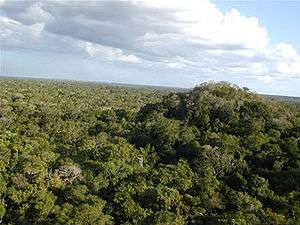Mirador Basin

The Mirador Basin is a geological depression found in the remote rainforest of the northern department of Petén, Guatemala. Mirador Basin consists of two true basins, consisting of shallowly sloping terrain dominated by low-lying swamps called bajos; one draining into the San Pedro River and the other into the Candelaria River. The basin is surrounded by rugged karstic limestone hills on the east and south, forming a triangular geographical "trough" covering more than 2,169 square kilometres (837 sq mi).
During the past two decades, the region has been the object of archaeological investigations at the large Middle and Late Preclassic sites of El Mirador, Nakbe, El Tintal, Wakna, the recently discovered sites of Xulnal and El Pesquero, and numerous smaller settlements, dating mostly to the Classic period, such as La Florida, Maaxte, Zacatal, Chan Kan, Tsab Kan, Pedernal, Isla, La Muerta, and La Muralla. Dozens of additional sites are dispersed within the Basin, including several extremely large ones such as Naachtun in the northeast corner which is currently under investigation by a team from the University of Calgary in Canada (Director: Kathryn Reese-Taylor). The primary settlement of the major sites in the basin dates to the Middle Preclassic (ca. 1000 BCE - 350 BCE) and Late Preclassic periods (ca. 350 BCE - CE 150), with relatively little overburden from the large scale constructions and extensive settlements that characterized the Classic periods (CE 250-900) of Lowland Maya civilization.
Illegal logging and forest fires resulting from slash and burn agricultural practices threaten Mirador Basin's rich biodiversity. Looting is also a major threat to the many Mayan archaeological sites that reside in the Basin. While many sites are known, others remain undiscovered and, according to Richard Hansen, "by the time scholars get there, looters may already have plundered them."[1]
The region belongs to the Maya Biosphere Reserve that represents the last large area of intact tropical rainforest remaining in Mesoamerica. Archaeological and environmental studies conducted by the Mirador Basin Project, directed by Richard Hansen, previously known as the Regional Archaeological Investigation of the North Petén, Guatemala (RAINPEG) Project, have identified data relevant to the origins and early development of the Maya civilization in this area. The executing organization for the research is the Foundation for Anthropological Research and Environmental Studies (FARES), and the Institute for Mesoamerican Research at Idaho State University, where Hansen is the Chief Senior Scientist.
Research and development of the Mirador Basin occurs in close cooperation and collaboration with the Guatemalan Institute of Anthropology and History (IDAEH), the Guatemalan Ministry of Culture and Sports (Ministerio de Cultura y Deportes), the Guatemalan Institute of Tourism (INGUAT), the National Council of Protected Areas (CONAP), and the Presidency of the Republic of Guatemala. In addition, projects work closely with community organizations in the department of Petén. The Inter-American Development Bank, along with The National Geographic Society, the Foundation for Maya Cultural and Natural Heritage- Fundación del Patrimonio Cultural y Natural Maya (PACUNAM), the Global Heritage Fund, and the Friends of the Natural and Cultural Heritage of Guatemala (APANAC), the Carlos Novella Foundation, among other private sponsors, have given economic support to projects in the Basin.
Notes
- ↑ Hansen 1997: 48
References
- Alvarado, Gilberto (1994). "Aspectos Ecológicos del Norte del Peten, Guatemala.". In Richard D. Hansen. Investigaciones Arqueológicas en Nakbe, Peten: El Resumen de la Temporada de Campo de 1993 (in Spanish) (Report filed with the Instituto de Antropología e Historia de Guatemala, Monumentos Prehispánicos, Guatemala ed.). Los Angeles: University of California, Los Angeles RAINPEG Project. pp. 113–138.
- Balcárcel, Beatriz (1999). "Excavaciones en Residencias Preclásicas de Nakbe, Peten". In Juan Pedro Laporte; Héctor L. Escobedo; Ana Claudia Monzón de Suasnávar. XII Simposio de Investigaciones Arqueológicas en Guatemala, 1998 (in Spanish). Guatemala City: Museo Nacional de Arqueología y Etnología, Ministerio de Cultura y Deportes, Instituto de Antropología e Historia, Asociación Tikal. pp. 337–352. OCLC 42674202.
- Balcárcel, Beatriz (2000). "Excavaciones en Residencias Preclásicas, Nakbe, Peten". In Richard D. Hansen; Judith Valle. Investigaciones Arqueológicas y Ecológicas en la Cuenca Mirador, 1998: Informe de la Temporada de Campo (Report filed with the Instituto de Antropología e Historia de Guatemala, Monumentos Prehispánicos, Guatemala ed.). Guatemala City; Los Angeles: Proyecto Regional de Investigaciones Arqueológicas del Norte del Peten, Guatemala (PRIANPEG); University of California, Los Angeles RAINPEG Project; FARES Foundation, Idaho. pp. 297–329.
- Gill, Richardson B. (2000). The Great Maya Droughts: Water, Life, and Death. Albuquerque: University of New Mexico Press. ISBN 0-8263-2194-1. OCLC 43567384.
- Hansen, Richard D. (September–October 1997). "Plundering the Petén" (online abstract). Archaeology. Vol. 30 no. 5. New York: Archaeological Institute of America. pp. 48–49. ISSN 0003-8113. OCLC 86456002.
- Hansen, Richard D. (1998). "Continuity and Disjunction: Preclassic Antecedents of Classic Maya Architecture" (PDF). In Stephen D. Houston. Function and Meaning in Classic Maya architecture: A Symposium at Dumbarton Oaks, 7th and 8th October 1994 (PDF online e-text reproduction). Washington, DC: Dumbarton Oaks Research Library and Collection. pp. 49–122. ISBN 0-88402-254-4. OCLC 38936552.
- Morales-Aguilar, Carlos; Douglas Mauricio; Abel Morales Lopez (2006). "Nuevos datos sobre el asentamiento del sitio arqueologico El Mirador, Peten, Guatemala: Reporte de Campo 2005.". In Edgar Suyuc; Richard D. Hansen. Investigacion y Conservacion en los sitios arqueológicos El Mirador, La Muerta, Wakna, El Porvenir, El Guiro, La Iglesia, La Sarteneja, Chab Ché y la Ceibita: Informe Final de la Temporada 2005 (in Spanish) (Report filed with the Instituto de Antropología e Historia de Guatemala, Monumentos Prehispánicos, Guatemala ed.). Pocatello: Idaho State University FARES Foundation. pp. 221–317.
External links
- FARES Foundation
- Mirador Basin Project website - archaeological program: directed by Richard Hansen
- Global Heritage Fund (GHF) - Working to establish a 810,100-acre (3,278 km2) Archaeological and Wildlife Preserve in the Heart of the Maya Biosphere